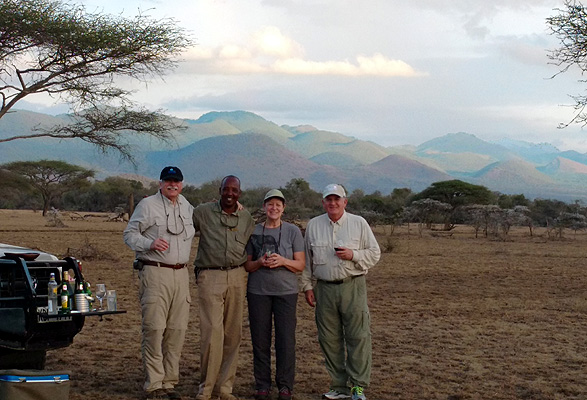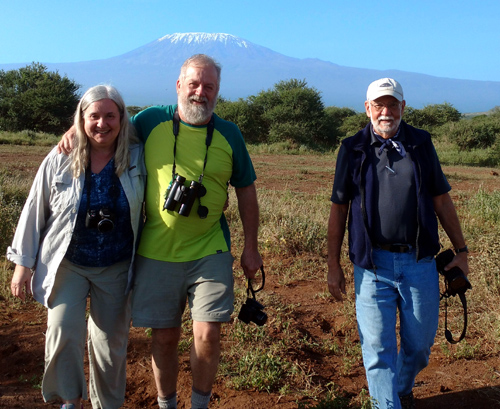Starting a safari in Tsavo West insures a memorable safari. But don’t drive!
My 60th birthday safari began in Tsavo West at Kilaguni Lodge, in part because it was where my kids, Brad and Elizabeth, had their first safari when they were little, and in part because over the years clients have told me that starting at Kilaguni was the best thing I suggested they do.
Tsavo West is exactly what people imagine Africa to be: endless vistas of scrubland brush, acacia trees and open savannahs. But the surprise of seeing jutting mountains sculpting a Grand Canyon like landscape, including Mt. Kilimanjaro, leaves them breathless.
Kilaguni was Kenya’s first non-hunting game lodge. Now owned by Serena Hotels, the rooms are comfortable if compact, and the original long verandah which overlooks the water holes has been preserved in tact. The vista which greets incoming guests is stunning, and I’ve had more than a few clients forego a game drive to just sit on the verandah taking it all in.
Dining is just off the verandah, and every room looks onto the water holes, so Africa just never stops. An unending parade of Africa marches to and fro. We watched elephant families, baboon troops, zebra herds; waterbuck strut right under the verandah, giraffe spread their legs to drink, every night began with the Verreaux’s eagle owl pruning itself in the spotlights, and hours after we had to leave we heard that a leopard was seen drinking at the water hole in broad daylight.
The first game drive ended at Rhino Ridge with a sundowner, and though a bit windy, my son Brad and nephew Tim rock climbed onto the highest boulder. They were probably a thousand feet above the Athi Valley, and we all watched elephant coming down to drink in a vista that was now nearly as deep as it was wide!
Game viewing in Tsavo was sobering because of the lack of rain that may have begun to reverse while we were there. But all the grazers were in dire shape. Normally buffalo and hippo are too rotund to allow bone structures to appear, but this time there was hardly an animal whose skeleton didn’t show. We saw one dead hippo and another dying under a tree. There just was no grass.
There had been just enough rain in the last several seasons to keep the trees green, and many new leaves created a stunning blue green color over the veld. Browsers like giraffe and elephant were doing just fine, and some of the gazelle were seen browsing as well. The zebra – although grazers – weren’t too bad, and they were chomping the dried long grasses just like horses consume winter hay.
But those animals that would only eat grass, like buffalo and hippo, were dying. Fortunately, very heavy rain fell both of the days we were there. We hope the dry spell has been broken.
But the highlight of the game viewing came as we returned to what was apparently a road kill of a zebra. As we approached, Carley Flores screamed. (Everyone’s allowed one scream, but it’s well known that human sounds disturb wild animals. They don’t mind diesel chugs, screeching ball bearings, car fumes or even whining breaks. But the great variety of human voices is threatening.)
On the road kill zebra was a pride of 9 lion. In the less than 3 hours since we had seen it in the morning most of the zebra was gutted. All that was left were the feet, a small part of the head, the skin and hooves. Even the tail was gone, although hyaena and jackal were yet nowhere to be seen.
A full grown male lion can put down 50 pounds of raw meat. This zebra probably weighed around 500 pounds, of which 400 was sirloin. That’s just about right for a pride of 9 lion. We stayed with the pride for 90 minutes, putting together a fantastic story of the four mature females, the four nearly grown cubs and the grand pride master who stayed far in the distance.
Two of the nearly grown cubs were male. Young males are among the most gorgeous animals on the veld: their manes are sprouting like partially shaved Hollywood stars. They don’t yet have the scars of older males, and their faces are especially beautiful.
But normally they would have been kicked out of the family before they grew larger than their mother. They were definitely already larger than any of the mature females, and there was a lot of tension. As they approached the kill, there was deep growling throughout the whole pride. At least for the short time we were there, the mature females dominated them despite now being smaller.
But the day will come soon when the young male tries to mate. They will have to overcome the pride master, first, which would be a real feat, but if they did, their mothers will fight to the death before succombing.
Why were they still there? The only answer I could come up with is that the distressed situation on the veld is compromising a lot of normal animal behavior. We saw, for instance, mixed herds of impala. Normally impala are strictly found in all male (bachelor) herds, or in large harem herds with only one harem master. Yet several times we found mixed herds.
Elephant families do come together to water, dig for water, or to travel. But we found elephant families sharing the same tree shade for their midday naps. That’s quite unusual. I have to conclude that the dry spell, which we think is now ending, has somehow contributed to this anomalous behavior.
The game drive ended as we stopped the cars for a half hour at sunset and enjoyed sundowners. The start of the rainy season means gigantic cloud formations, distant rain and the beautiful flute-like cry of the rain birds like the crimson breasted shrike. I watched Steve Coates holding his Tusker but forgetting to drink as he stared endlessly into the beautiful African horizon.
We had heard that the “new road” between Nairobi and Mombasa made the road journey to Tsavo easy. Not true. The road isn’t done. It is only done from Machakos south, and the journey from Nairobi city is excruciating. Until this highway really is done, I’ll be flying from now on.
We left Tsavo newly excited. It seemed to everyone that things just couldn’t get better!
 The seasons changed in front of us. We flew into Chyulu Hills near Tsavo in Kenya in the dry season, and two days later the veld had transformed with some of the heaviest rains I’ve ever seen. It was beauty incarnate.
The seasons changed in front of us. We flew into Chyulu Hills near Tsavo in Kenya in the dry season, and two days later the veld had transformed with some of the heaviest rains I’ve ever seen. It was beauty incarnate.
